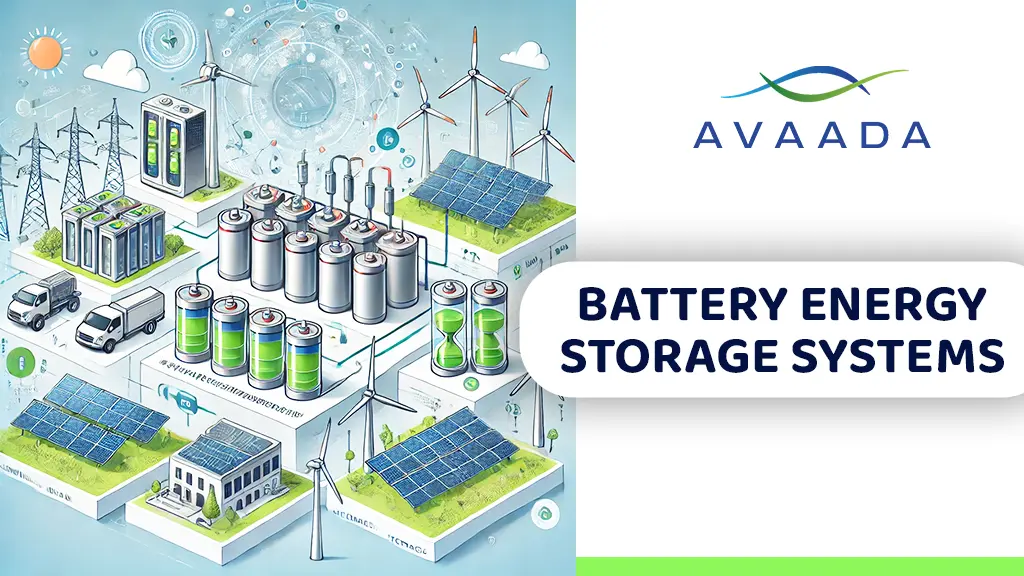Battery energy storage systems (BESS) are a crucial component in the transition to a sustainable energy future. These systems allow for the storage of excess energy generated from renewable sources like solar and wind, and then release it when needed, ensuring a reliable and stable power supply. In this blog, we will delve into the importance, benefits, and various types of BESS, as well as their applications and future prospects.
Importance and Benefits of BESS
Battery energy storage systems are essential for several reasons.
- Help in the integration of renewable energy sources into the grid. Renewable energy, such as solar and wind power, is intermittent and unpredictable, making it challenging to manage the grid. BESS can store excess energy during periods of high production and release it during times of low production, ensuring a consistent supply of electricity. This not only reduces the reliance on fossil fuels but also helps in achieving net-zero carbon emissions.
- BESS provides backup power during outages or grid failures. This is particularly important for critical infrastructure and emergency services that require a continuous power supply. BESS can be rapidly deployed and can transition from standby to full power in under a second, making it an effective solution for grid stabilization and contingency planning.
- BESS helps in managing peak demand. During peak hours, the demand for electricity is high, and traditional power plants struggle to meet this demand. BESS can be charged during off-peak hours and then discharge during peak hours, reducing the need for additional power plants and minimizing the strain on the grid.
- BESS can generate new revenue streams for utilities and consumers. By participating in energy arbitrage, BESS can buy energy at low prices and sell it at higher prices during peak hours, thereby reducing electricity bills and increasing profitability.
Explore our blog for various tips on reducing your electricity bills.
Types of BESS
Lithium-Ion Batteries
Lithium-ion batteries are currently the dominant technology for large-scale BESS. They are widely used due to their high energy density, long lifespan, and relatively low cost. Lithium-ion batteries are used in a variety of applications, from electric vehicles to industrial and residential buildings.
Compressed Air Energy Storage
Compressed air energy storage systems use surplus power to compress air, which is then stored in large chambers. When energy is needed, the compressed air is released and passes through an air turbine to generate electricity. This technology is particularly useful for long-term energy storage and can be used in conjunction with other energy sources.
Mechanical Gravity Energy Storage
Mechanical gravity energy storage systems use energy to lift heavy objects, such as concrete blocks, up a tower. When energy is needed, the blocks are lowered back down, generating electricity using the pull of gravity. This technology is less common but can be effective for long-term storage and high-energy applications.
Flow Batteries
Flow batteries are rechargeable fuel cells that use chemical energy provided by two chemical components dissolved in liquids contained within the system. These batteries are designed for long-term storage and can be charged and discharged many times. They are particularly useful for large-scale applications and can be used in conjunction with other energy sources.
Applications of BESS
Grid Stability and Peak Shaving
BESS can be used to stabilize the grid by providing operating reserves and frequency control. They can also be used for peak shaving, reducing the need for additional power plants during peak hours. This helps in managing the grid’s load and ensuring a stable power supply.
Renewable Energy Integration
BESS are essential for integrating renewable energy sources into the grid. They can store excess energy generated from solar and wind power and release it when needed, ensuring a consistent supply of electricity. This helps in reducing the intermittency of renewable energy sources and increasing their overall contribution to the grid.
Backup Power and Emergency Services
BESS can provide backup power during outages or grid failures. They can be rapidly deployed and can transition from standby to full power in under a second, making them an effective solution for emergency services and critical infrastructure.
Industrial and Commercial Use
BESS are used in industrial and commercial settings to manage energy consumption and reduce costs. They can be charged during off-peak hours and discharged during peak hours, reducing the need for additional power plants and minimizing the strain on the grid. This helps in improving energy efficiency and reducing energy bills.
Future Prospects
The future of BESS is promising, with significant advancements expected in the next decade. New technologies and innovations are being developed to improve the efficiency, cost-effectiveness, and lifespan of BESS. For example, new battery chemistries and advanced control systems are being explored to enhance the performance of BESS. Additionally, the integration of BESS with other energy sources and smart grid technologies is expected to further improve their effectiveness and reliability.
Battery energy storage systems are a vital component of the transition to a sustainable energy future. They provide numerous benefits, including the integration of renewable energy sources, grid stability, peak shaving, and backup power. The various types of BESS, such as lithium-ion, compressed air, mechanical gravity, and flow batteries, cater to different applications and energy storage needs. As the technology continues to evolve, BESS will play an increasingly important role in the global energy landscape, helping to reduce carbon emissions, improve energy efficiency, and ensure a reliable and stable power supply.








